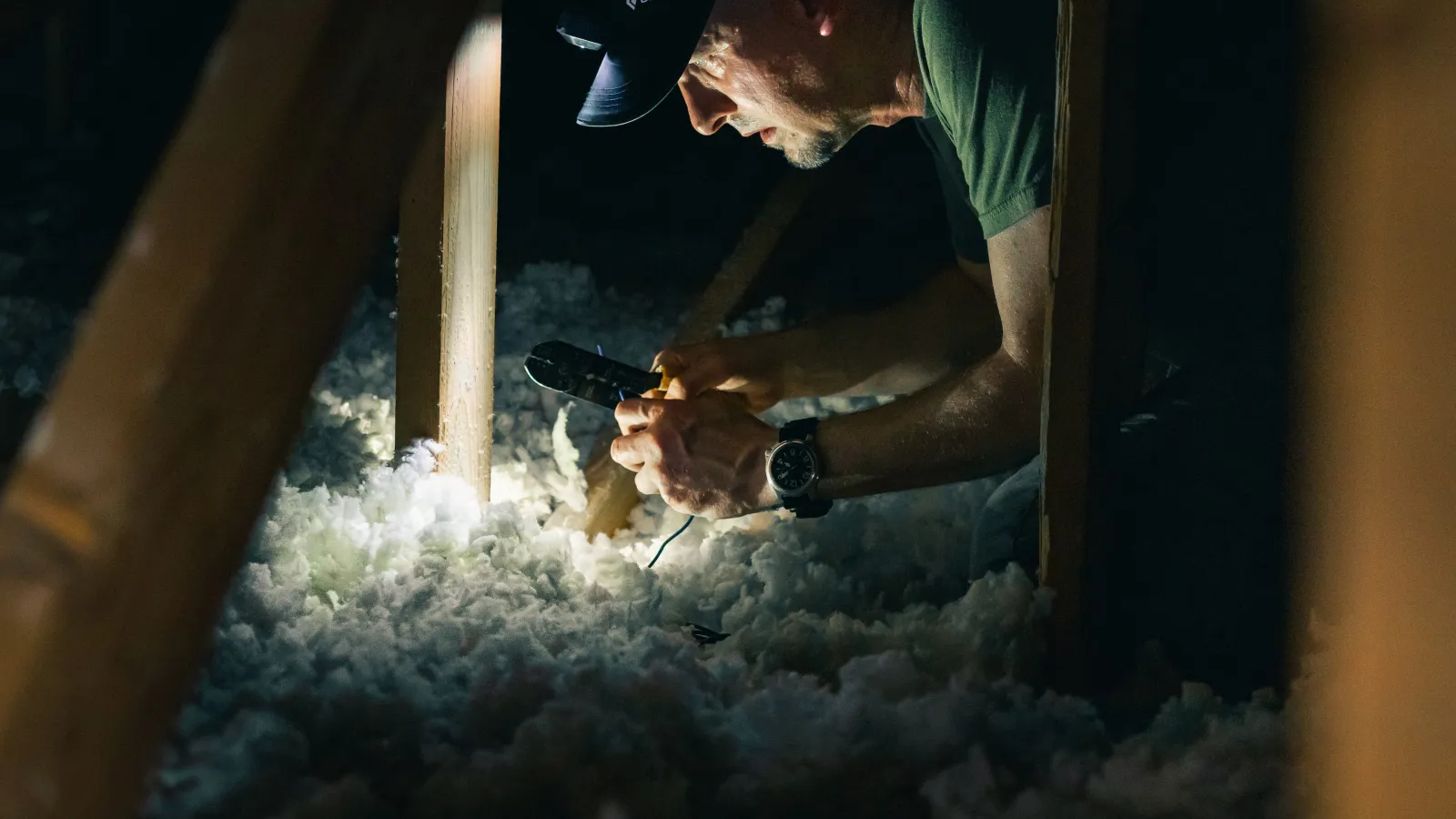5 FAQs to Learn How Home Insulation Works in the Summer

Tired of high summer electric bills due from blasting the A/C to cool your home? Do you sit by the fan to cool off whenever you get home? Did you know that home insulation helps keep your house cool in the warm weather? Interested in a home project that pays for itself within a year and keeps your home comfortable every season?
Yes, home insulation is more than a one season solution to your home comfort.
We all recognize the fact that insulation helps keep our homes warm in the winter. However, not many of us understand that the same principles help in the summer.
To help, learn about home insulation basics with these five FAQs! If you have any questions or want to understand how proper insulation helps your home, call Snappy today!
1. How does home insulation work?
In the warm months, heat is constantly seeking cooler places, drawn to your comfortably air conditioned home. Without sufficient insulation, that heat will simply move through the walls and drive down your indoor comfort.
In simple terms: insulation blocks heat from entering the home in the summer and holds heat in during the winter, which results in a cooler home in the summer, warmer home in the winter, and lower energy bills.
As experts in home efficiency, the team at Home Power notes:
"In the summer, attic insulation helps reduce heat gain through the ceiling to living spaces below. In the winter, it helps slow heat loss from the interior spaces."
It's that simple and it really works.
For any homeowner considering adding or reviewing their insulation, then keep in mind that its cost is often paid for through energy savings in less than a year!
2. Are there different types of home insulation?
Yes. It is worthwhile for homeowners to understand how each type of insulation may help their home.
Ceiling Insulation
With energy costs on the rise, homeowners must ensure their home contains properly insulated. Ceiling insulation provides essential sound control between the floors of your home. We specialize in basement ceiling insulation, insulation above the living room and more.
Wall & Floor Insulation
Georgia, like in most climates, requires insulation on all sides of the house: under your flooring, in basement walls, and at the ceiling or roof. Wall and floor insulation is an effective way to maintain comfortable temperatures throughout your home. Although often forgotten, wall and floor spaces remain an important component requiring insulation in your home. Are your hardwood floors cold in the winter? Snappy can solve this issue! We offer free energy assessments to determine the cause of the burdensome issue.
Attic Insulation
Heat passes easily through a poorly insulated attic which can cause a drastic increase in your energy bills. Naturally, heated interior air rises, especially in chilly winter months, and is lost through numerous attic air leaks. To tackle these issues, we first seal the air leaks, followed by new or additional attic insulation. Types of attic insulation we offer include: cellulose, fiberglass, mineral wool, spray foam, and rigid foam. Ask your service representative about our Green Fiber products which create a great sound barrier as well as being pest and rodent resistant.
Duct Insulation
Uninsulated duct work is located in your attic, basement or crawlspace. Your ductwork will have the same temperature as those spaces. This means your ductwork has to heat up before heating your home, making it work twice as hard. Duct insulation will improve your comfort and energy performance. The Snappy team also specializes in duct sealing, as duct sealing and insulation go hand-in-hand.
Crawl Space Insulation
Builders often forgo crawl space insulation or install the incorrect type, and vent the space to the outside allowing warm and cold air into the space along with moisture. This can cause a home to become uncomfortable, as well as encourage mold growth, damp crawl space, or wood rot due to moisture entry.
Fortunately, Snappy installs rigid foam insulation. This insulation, specially made for crawl spaces, prevent the absorption of moisture or mold growth. We also offer crawlspace encapsulations which eliminate moisture and mold issues, creating a separation from the Earth between you and your home.
Additionally, reducing or eliminating irritating pest and rodent issues remains another result of proper crawl space encapsulation. Plus, many crawl spaces contain a heating and air system. If your crawl space is not properly air sealed, then damp air likely enters your home. As a result, the air quality in your home erodes over time. Finally, properly air sealed and encapsulated crawl spaces cut your heating and cooling costs by 15-20%? Why? The crawl space connects the conditioned space and vents outside!
3. What causes our home discomfort in the summer?
The home energy efficient experts at GreenHomes America explain how our homes operate in the summer:
"The first thing to understand about our homes during the summer is that they lose much more air to the outside than most people realize. It is a continual, silent process that goes on every moment of every day all summer long.
To make matters worse, at the same time you are losing the cool air you are paying to condition, an equal amount of hot, humid air from outside then enters your home to replace the cool air that was lost. This invisible process called air exchange is typically one of the main contributing factors for hot, sticky homes during the summer.
In addition to the large amount of air escaping from your home during the summer, most homes do not have enough insulation to slow the heat that is outside of your home from entering through ceilings, walls and floors. This high rate of heat gain causes walls, floors and ceiling surfaces to heat up causing warm, uncomfortable conditions inside of your home.
On the positive side, once the underlying reasons for the uncomfortable conditions in your home are determined, a solution can be identified that greatly improves comfort while saving energy for the occupants."
As a solution, GreenHomes America recommends air sealing and insulation. The air sealing keeps the air in your home, well, in your home and prevents outside air from entering.
Insulation should be increased in a variety of places, such as:
- wherever there is no insulation.
- poorly installed insulation.
- insulation only meets a minimum thickness.
- exterior walls or floors over unheated spaces.
Regardless of the location in your home, insulation should always be installed to be continuous and to the proper thickness (and ALWAYS after air sealing first).
INSULATE WHERE NEEDED!
4. How can I get the most out of my home insulation during the summer?
In general, insulating the key areas of your home creates a barrier. This barrier prevents heat from entering your house on a hot, humid day.
During the summer months, insulation has to work to reduce the transfer of heat from the roof into the attic spaces and down into the home itself. It is important to note that a proper and well-installed attic can reduce heat transfer by up to 25% or more, preventing the summer sun from baking it's way all the way down to your living room.
Insulation, whether foam, fiberglass, or cellulose, provides a barrier against the transfer of heat in and out of your home. The insulation, which prevents the heat transfer from shingles and siding also reduces the overall workload required by the cooling system. Over all, the energy required to keep your home at optimum temperature and humidity is decreased in a well-insulated home. That means less money spent on utility bills!
There are a few other useful tips to make sure the heat stays outside and the cool air is inside!
- Air circulation is really important, so open as windows at night to allow your home to cool.
- Circulating air with fans is fine, but anything electrical creates an increase ambient temperature and the insulation will trap in the heat.
- Turn all non-essentials off or try putting some water or ice in a dish under the fan.
5. Is there anything else should I know about home insulation?
According to the Department of Energy, proper air sealing and insulation can reduce your home's energy costs by as much as 30%!
Insulation works best when air is not moving around or through it. This being said, it is very important to seal air leaks first to ensure you get the best possible results from your insulation.
However, by adding insulation without air sealing first will only give you minimal improvements.
In most homes we provide services to, we see insulation that was improperly installed or not installed at all in some areas. It is very common for us to see little to no insulation in the attic. You can go to your attic and look around; if you can see your ceiling joists, you need additional insulation.
Frequently, homes maintain a minimum amount of insulation, which building codes require. However, the standards do not provide sufficient or proper insulation. The result are homes with:
- drafty areas.
- energy loss.
- increased utility bills.
- an overall uncomfortable home.
You may ask yourself what kind of insulation does my home need? Where do I need it most? SolvIt is here to answer all of your questions and we even provide a FREE quote and estimate, finding the correct areas and type(s) of insulation your home would benefit from most.

